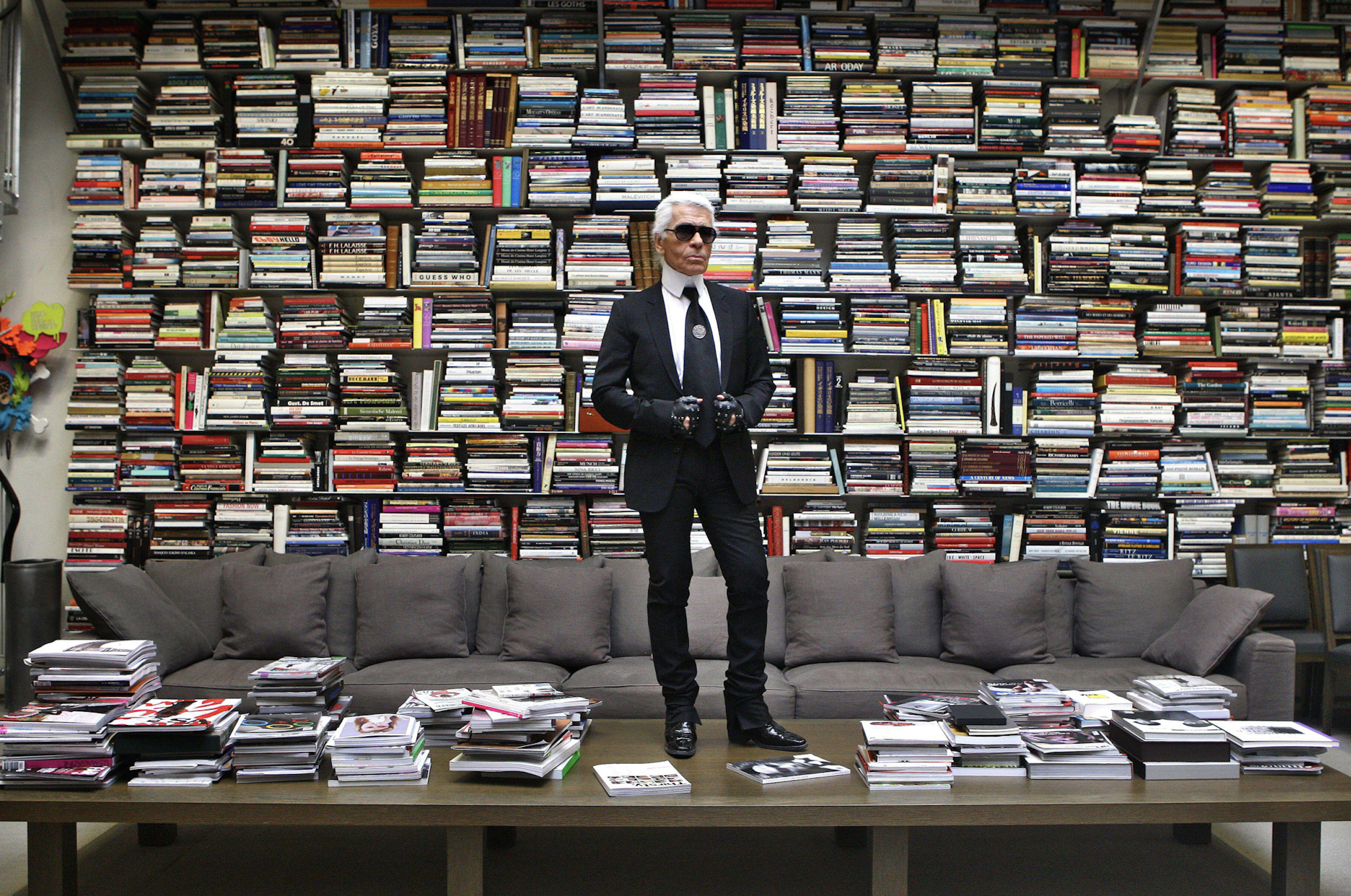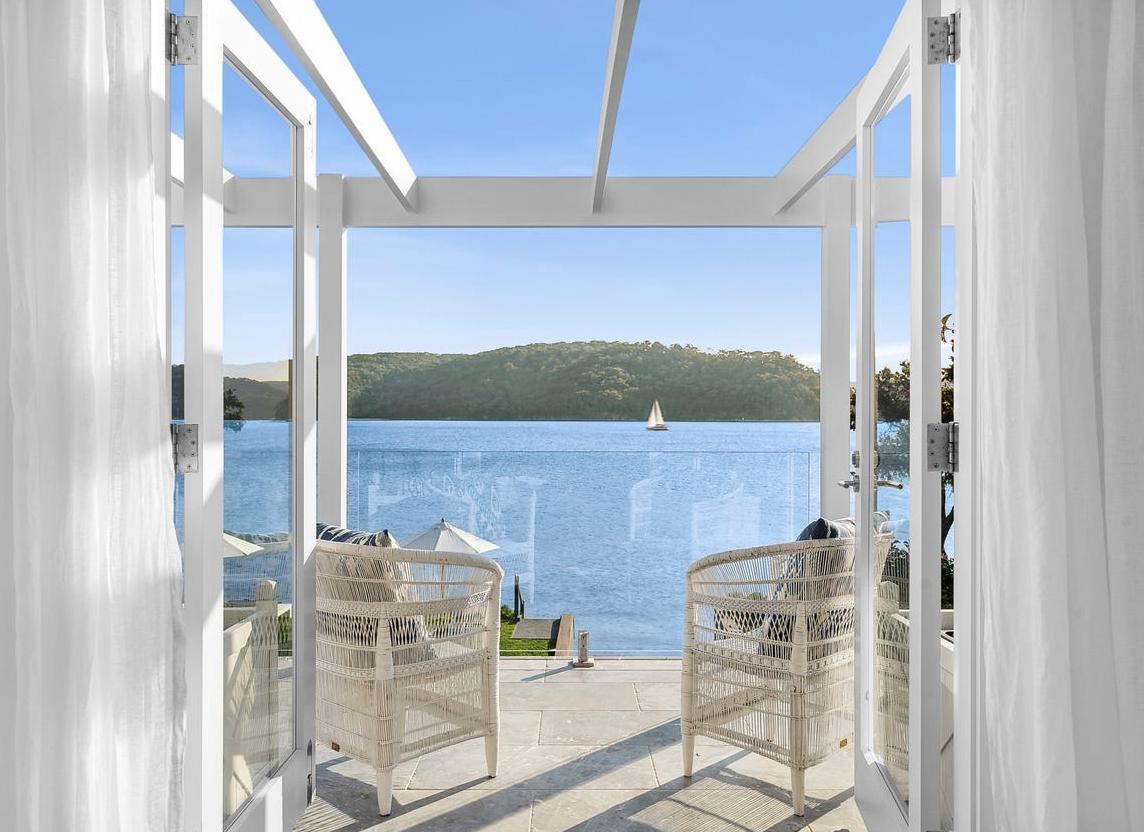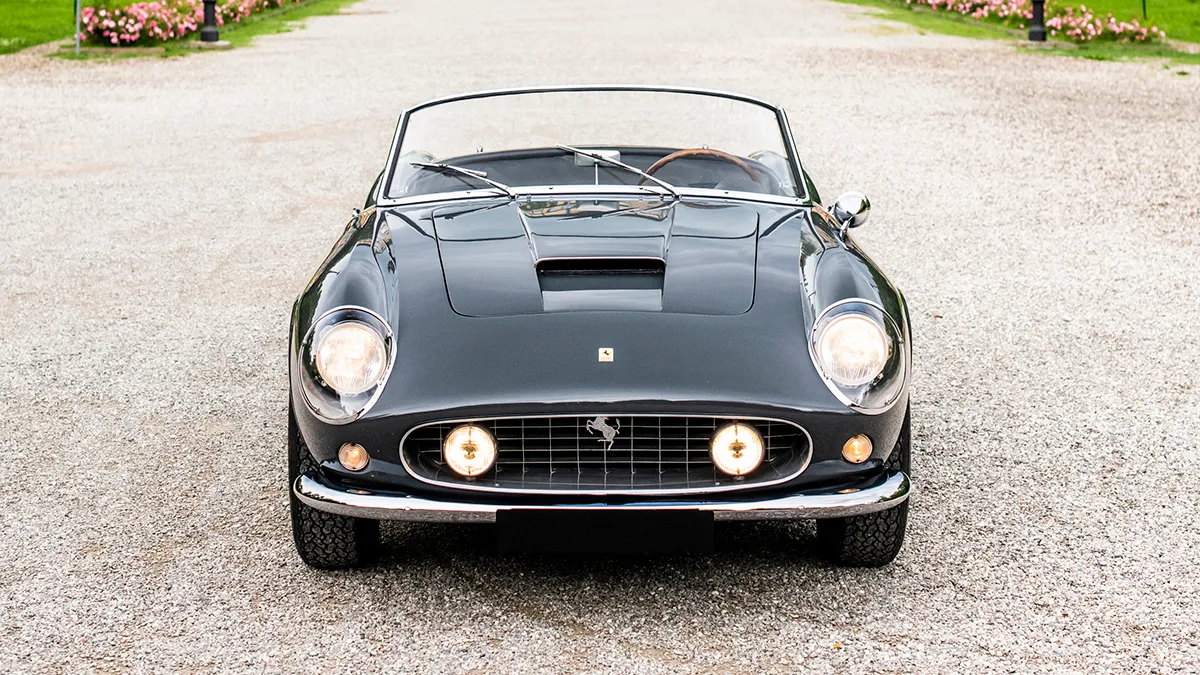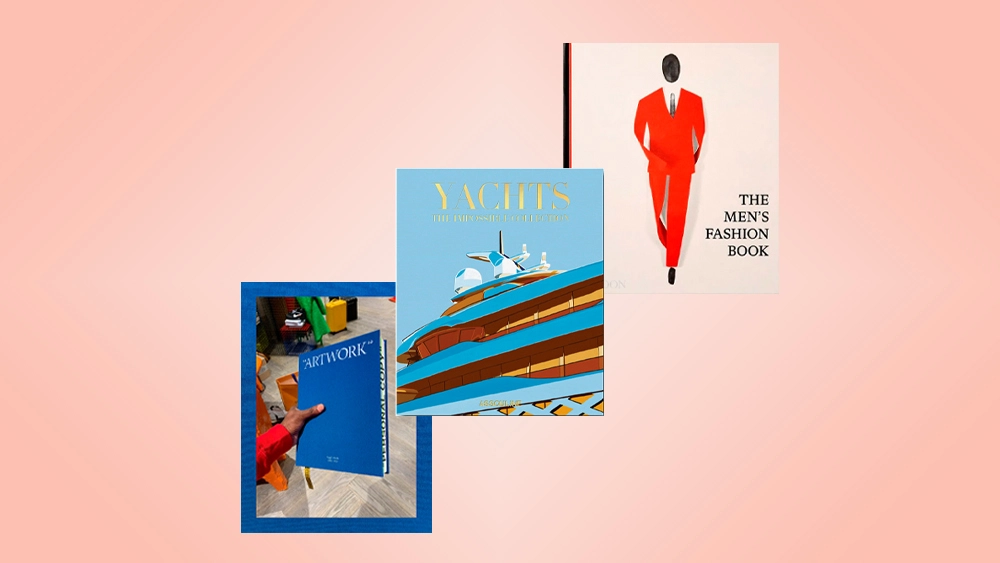
The 30 Best Coffee Table Books To Give Your Living Room A Dose Of Smart Style
Tomes that are great to read and show off.
Related articles
There are few gifts more elegant than an artfully selected coffee table book. A well-designed tome is a holiday classic for a reason: It tells a story, doubles as a design object and ultimately makes a room, serving as a subtle (or not-so-subtle) interior statement. Who can forget how Tom Ford’s eponymous first monograph populated seemingly every celebrity home, adding a certain authoritative, high-octane touch to any space it graced? Likewise, a tasteful Slim Aarons monograph or the oeuvre of a top photographer are perennials. In short, the right physical book leaves an imprint no Kindle can.
When it comes to the best coffee table books, options are wide and seemingly never ending. This is where our curation comes in. We’ve leafed through the most promising of 2022’s many releases and zeroed in on the top coffee table books for everyone on your list. Whether their passion is sailing, travel, classic cars, minimalist architecture, maximalist design and beyond, we’ve got you covered. From the critically acclaimed, first English-language Piet Mondrian biography released in 50 years to an expansive exploration of era-defining yachts and monographs for the classic Hollywood devotee, look no further than the coffee table books below.
Best Gift for Warholites
Pop Art Style

Decades ago, Andy Warhol threw the art world on its head, bringing in a crayola-coloured satirization of contemporary life and predicting the social media era 40-plus years before Instagram launched. Assouline’s new monograph Pop Art Style, part of a larger series on style, traces the aesthetics and ethos of Warhol and his contemporaries in colourful, dynamic form. With enough industrial design objects, graphic arts and, of course, explorations of celebrity.
Best Gift for Boaters
Riva Aquarama

Carlo Riva legend in the boating world is unparalleled, especially when it comes to runabouts. Celebrating his impact on the industry is this 208-page coffee table book, an expansive tome that offers interviews with Riva fans, including Simon Le Bon and Arpad Busson, along with historical pictures and contemporary images by photographer Oliver Pilcher.
Best Gift for F1 Fanatics
F1 Heroes: Champions and Legends in the Photos of Motorsport Images

With 200-plus images spanning 70 years of Formula 1, F1 Heroes dives into the storied history of racing legends, taking the reader from the very first championship to Lewis Hamilton’s groundbreaking wins and an inside look at the early automobiles. This is as much a gift for classic car collectors as F1 fans. A few highlights include for early histories of Ferrari, Alpha Romeo and Maserati.
Best Gift for Abstract Thinkers
Piet Mondrian: A Life

As a co-founder of the De Stijl movement and a leader in abstraction, the Dutch painter Piet Mondrian’s influence can’t be underestimated. This is the long overdue, critically-acclaimed, first English-language biography of the artist in 50 years, complete with previously unknown letters, archival material and a rich progressive exploration of Mondrian’s creative and personal development.
Best Gift for Aspiring Screenwriters
A24 Screenplay Books

Production house A24 has changed how the public engages with the film studio, developing a cult following in the way once reserved for directors and movie stars. Now, the company is releasing the full original screenplays of some of their most beloved high-brow cinema. The true obsessive can dive into the collector’s editions of Moonlight, Ex Machina or Minari, the latter annotated with photographs from the director’s childhood and an original essay by poet Ocean Voung.
Best Gift for Minimalists
Japanese Interiors

A love letter to Japanese interiors that takes you inside private homes from the city to the seaside, this Phaidon tome is an expansive showcase of the nation’s top architects and the generations they’ve inspired. The book surveys Japan’s renowned less-is-more design aesthetic—from the avant-garde to the traditional, with plenty to take in for minimalists.
Best Gift for Hollywood Insiders
Annie Leibovitz

Annie Leibovitz is a photography legend, having lensed Hollywood’s A-list in theatrical, timeless images for many top magazines. Now, photography and film fans alike can sink into her expressive work, which range from intimate portraits of the late Queen Elizabeth to photojournalism made for Rolling Stone in the ’70s and iconic images of stars throughout the decades on set.
Best Gift for Hypebeasts
Virgil Abloh: Figures of Speech

In his brief 41 years, the late Virgil Abloh left a deep imprint on fashion, music and culture en masse, breaking barriers as the first Black menswear artistic director of Louis Vuitton and redefining what it means to be a multi-hyphenate. Virgil Abloh: Figures of Speech functions as a user manual to the creative polymath, decoding Abloh’s designs and taking you through his substantial output. Look for pieces from his personal archive, prototypes and deep dives into the designer’s use of language and references.
Best Gift for Footballers
Football: Designing for the Beautiful Game

More than any sport, soccer is a universal game. It’s called the beautiful game for a reason. This catalogue approaches the sport from a design lens, delving into the development, details and innovations behind iconic cleats, stadiums and balls the world over. It includes though- provoking contributions from the players and designers alike.
Best Gift for Cinephiles
Bob Willoughby: A Cinematic Life

Photographer Bob Willoughby led an extraordinary life, capturing the likes of Elizabeth Taylor, Elvis Presley, Frank Sinatra and so many other legends of film and jazz from the 1950s through the 1970s . This large format monograph takes you inside his incredible career, where he was the first ever “outside” photographer hired by major movie studios–complete with insider stories from the sets of The Graduate, Rebel Without a Cause and many more.
Best Gift for Chefs
Ghetto Gastro: Black Power Kitchen

From the Bronx-based culinary collective founded by Pierre Serrao, Jon Gray and Lester Walker, and James Beard Award-winning writer Osayi Endolyn comes the book Vogue called the year’s most important cookbook.” Inside, you’ll find 75 mainly plant-based recipes celebrating Black food and culture, interwoven with immersive storytelling, interviews, photography and other visuals. It’s a rich text filled with depth and mouth-watering eats, drawing inspiration from the Bronx’s diverse communities.
Best Gift for California Dreamers
George Byrne: Post Truth

Photographer George Byrne’s monograph Post Truth is an optimistic take on Postmodernism, deconstructing Los Angeles’s urban sprawl and transforming its disparate pieces into a candy-coloured architectural utopia. The book’s pages reimagine the city in dreamy pastel form, referencing seminal California artists Ed Ruscha and David Hockney, while also calling to mind Miami’s Art Deco district. It’s a beautiful photographic ode to the city’s most picturesque corners, fit for anyone who loves Los Angeles or a good Pop Art moment.
Best Gift for Bookworms
Joan Didion: What She Means

Written and curated by New Yorker contributor Hilton Als, What She Means explores the seminal author’s life and work through a visual lens, with contributions from 50 artists including Ed Ruscha, Brice Marden, Betye Saar and Andy Warhol. It’s a must-have for anyone who loves Didion’s poignant work. It also includes three previously uncollected texts by the writer.
Best Gift for Escapists
St. Barth’s Freedom

A beautiful journey through the legendary calm and glamour of the wealthy Caribbean enclave, Assouline’s St. Barth’s Freedom is sure to transport you back through its pages. The rich monograph is enthralling and nostalgic at the same time, taking you from Eden Rock to the seaside with vibrant photography and over 200 hand-drawn illustrations.
Best Gift for Maximalists
Gold: The Impossible Collection, Special Edition

This is for the person on your list for who already has it all. From Gustav Klimt to Yves Klein, Andy Warhol, haute couture detailing, royal crowns and so many other works of extravagance throughout history, this collector’s edition—with a hand-painted gold clamshell case—is a fantastical exploration of the precious metal. It’s extra from the inside out—both literally and figuratively.
Best Gift for Ecologists
Botanical: Observing Beauty

A gorgeous exploration of the interdependence and creative tension between art and science, Botanical: Observing Beauty originated in an exhibition at Beaux-Arts Paris. The book touches upon jewellery, drawing, scientific illustrations–even video games–as it wonders through artistic explorations of botany. It’s a beautiful, clever gift for the botanist, and an elegant ode to nature.
Best for Ski Bunnies
100 Slopes of a Lifetime

Celebrate winter’s beloved pursuit—and any ski bunnies in your life—with this gorgeous tome from National Geographic. Written by a former editor of Outside magazine, and featuring a forward by Olympic alpine skier Lindsey Vonn, the book shines a light on trails across an array of terrains and skill levels, from dramatic cross-country routes to experts-only back-country options.
Best Gift for Architecture Junkies
How Architecture Tells: 9 Realities That Will Change the Way You See

“Sculpting space has the power to shape life,” says Robert Steinberg, and this book of 200 full-colour photos showcases many of the ways in which architecture can do just that. A futurist, activist, storyteller and fellow of the American Institute of Architects, Steinberg spotlights how some of his public projects have helped raise up and bring together different communities, and how architecture can help spur social change and collective healing.
Best Gift for Fine Art Lovers
Frida Kahlo: The Complete Paintings

Take in the works of Frida Kahlo like never before with this large-format book celebrating the visionary Mexican artist. The collection traces Kahlo’s life and career through drawings, letters, photos, diary pages and images of her paintings—including pieces in private collections that have rarely been seen by the general public, and reproductions of works that have been lost or unseen for over 80 years. It’s the ultimate study of Kahlo’s work for her legion of admirers.
Best Gift for Sailors
Yachts: The Impossible Collection

Head out onto the high seas with this carefully curated anthology of notable vessels from throughout history. From the 1851 ship for which the America’s Cup was named and the J Class racing yachts of the early 1900s to the sleek megayachts of today (and tomorrow), these are the boats that broke the mould and helped to define their era. The book also spotlights how things like design, green technology, speed, luxury amenities and more have played a part in transforming the yachting seascape.
Best Gift for Prepters
Polo Heritage

Born of the training cavalry units of Asia, polo has spanned continents and cultures to become one of the world’s oldest team sports, and the preferred “sport of kings.” Following a forward by legendary player Nacho Figueras, this book takes readers on a thrilling journey from Mongolia to Mexico, Barbados to India, for a look at some of the most prestigious tournaments, prominent polo families and notable grounds on grass, sand and snow.
Best Gift for Fashionable Men
The Men’s Fashion Book

Hundreds of contributors—from designers and photographers to tailors, editors, models, stylists and more—came together to help create the first truly comprehensive look at men’s fashion from the last 200 years. The A-Z guide spans genres and styles, spotlighting everything from the enduring nature of suiting and the popularity of streetwear to influencers like the Jamaican “rude boys” and tailor Manuel Cuevas, the man responsible for Johnny Cash’s all-black look. Images culled from runway shows, magazine shoots, film stills, vintage ads and more help bring each entry to life.
Best Gift for Car Collectors
The Porsche 911 Book

Dive deep into the iconic Porsche 911 with this 192-page hardcover that documents nearly every variant of the marque’s most beloved model. Originally released in 2013 for a limited run of 40,000 copies, the book was recently released in a revised edition, with text by Jürgen Lewandowski and photos by René Staud helping to bring to life the history, evolution and perennial appeal of this legendary ride.
Best Gift for Interiors Connoisseurs
Santa Fe Modern: Contemporary Design in the High Desert

Following the success of their books Texas Made/Texas Modern and Marfa Modern, author Helen Thompson and photographer Casey Dunn turn their spotlight on Santa Fe with this look at how architecture and design has evolved in the Southwestern city. The book takes readers into 20 contemporary and modernist residences to showcase how top architects and interior designers have been inspired by the high desert setting in their choice of styles, materials, form and more. Along the way, the text also offers historical context, expert insight and a look at some of the architects and artists who’ve made a big impact on today’s Santa Fe style.
Best Gift for Dog Owners
The Golden Retriever Photographic Society

Over his illustrious career, photographer and filmmaker Bruce Weber has shot everything from iconic fashion campaigns and portraits of countless A-listers to dramatic American landscapes. For nearly half a century, he’s been accompanied on his journeys by his beloved Golden Retrievers, who’ve often popped up in his photos. In this loving and personal new tome (which features a forward by Jane Goodall), Weber puts the focus squarely on man’s best friend, celebrating both his favorite breed and the ways in which one’s pets can fuel joy and creativity.
Best Gift for Travelers
Gray Malin: The Essential Collection

In 10 years, Gray Malin has gone from selling his prints at an LA flea market to venturing to all seven continents to create vivid shots that epitomize travel and escapism. This book chronicles the bestselling photographer’s first decade of work, and features images both signature—think the colourful aerial umbrella shots from Miami, Rio and Lisbon—to others that have never been published. It’s the perfect gift for anyone who’s having a bit of wanderlust or who needs a dose of sunshine to brighten up the winter.
Best Gift for Lovers of True Luxury
Peter Marino: The Architecture of Chanel

Where fashion and architecture meet, there’s Peter Marino. For the last 25 years, the architect has helped create striking buildings for the venerable French label in destinations from New York to Nanjing, along the way helping to elevate luxury retail into fine art. This book of over 300 images includes original sketches, architectural plans, project descriptions and more to help transport readers to the 16 global Chanel outposts for which Marino designed both the exteriors and interiors.
Best Gift for the Eco-Conscious
Koichi Takada: Architecture, Nature, and Design

Whether designing the National Museum of Qatar in Doha, an urban marketplace in New York City’s East Village or Australia’s “greenest residential building” in Brisbane, Koichi Takada draws from organic forms and local context to help reconnect people to the natural environment. In this, the first monograph on the Japanese-born, Sydney-based architect, photos of buildings and interiors are juxtaposed with sketches and images of nature to showcase the inspirations behind Takada’s striking creations.
Best Gift for Birdwatchers
Bird: Exploring the Winged World

Enjoy an engaging and visually stunning visit to the avian kingdom with this hardback tome that explores our fascination with the winged world, from ancient Egypt to the present. Over 300 images and illustrations sit alongside content from ornithologists, art historians, wildlife photographers, conservationists and curators to look at the role birds have played in everything from science and mythology to fine art and pop culture. Even the Twitter bird makes an appearance.
Best for Jetsetters
Gstaad Glam

Tucked among the snowy Alps of southwestern Switzerland is a magical land of exclusive ski clubs and elegant hotels, luxury boutiques and cutting-edge art galleries—and lots of beautiful vistas and people-watching in between. In this new book from Assouline, you’ll be transported to Gstaad for a glimpse at some of its stunning natural settings—from slopes to golf courses to polo fields—as well as at its iconic buildings, favorite local haunts and top events like the annual hot-air balloon festival and Menuhin Festival of music. The tome will tide you over until you can next make the scene yourself.
Best Gift for Wannabe Designers
Living in Colour: Colour in Contemporary Interior Design

Sure, this new home design and décor book from Phaidon provides plenty of aesthetic inspiration, thanks to its featuring of 200 interiors from 130 designers across dozens of room types, in locations around the world. But with its focus on how colour plays a part in how we design and live—and the fact that the book is organised by hue, spanning from pure white and deep black to vivid hot pinks and reds—there’s also something meditative about flipping through its pages and embarking on a visual journey across the colour spectrum. Text by colour historian Stella Paul and interior designer India Mahdavi helps bring it all together.
Best Gift for True Collectors
Assouline Bookstand

The large size that is a huge part of the charm of coffee table tomes can also make them a little awkward to read. To fully appreciate their expanse you’ll need a lot of open space or, better yet, a bookstand. If you’re interested in the latter, this deluxe version from Assouline is just the ticket. If you’re of the opinion that books can be art in, and of, themselves, it’s an elegant way to display one of the jewels in your current collection.
Subscribe to the Newsletter
Recommended for you
5 Lounge Chairs That Add Chic Seating to Your Space
Daybeds, the most relaxed of seating solutions, offer a surprising amount of utility.
July 22, 2024
Living La Vida Lagerfeld
The world remembers him for fashion. But as a new tome reveals, the iconoclastic designer is defined as much by extravagant, often fantastical, homes as he is clothes.
July 22, 2024
You may also like.
By Josh Bozin
24/07/2024
You may also like.
5 Lounge Chairs That Add Chic Seating to Your Space
Daybeds, the most relaxed of seating solutions, offer a surprising amount of utility.
Chaise longue, daybed, recamier, duchesse brisée—elongated furniture designed for relaxing has a roster of fancy names. While the French royal court of Louis XIV brought such pieces to prominence in fashionable European homes, the general idea has been around far longer: The Egyptian pharaohs were big fans, while daybeds from China’s Ming dynasty spurred all those Hollywood Regency fretwork pieces that still populate Palm Beach living rooms. Even Mies van der Rohe, one of design’s modernist icons, got into the lounge game with his Barcelona couch, a study of line and form that holds up today.
But don’t get caught up in who invented them, or what to call them. Instead, consider their versatility: Backless models are ideal in front of large expanses of glass (imagine lazing on one with an ocean view) or at the foot of a bed, while more structured pieces can transform any corner into a cozy reading nook. Daybeds may be inextricably linked to relaxation, but from a design perspective, they put in serious work.

Emmy, Egg Collective
In designing the Emmy chaise, the Egg Collective trio of Stephanie Beamer, Crystal Ellis and Hillary Petrie, who met as students at Washington University in St. Louis, aimed for versatility. Indeed, the tailored chaise looks equally at home in a glass skyscraper as it does in a turn-of-the-century town house. Combining the elegance of a smooth, solid oak or walnut frame with the comfort of bolsters and cushioned upholstery or leather, it works just as well against a wall or at the heart of a room. From around $7,015; Eggcollective.com
 Plum, Michael Robbins
Plum, Michael Robbins
Woodworker Michael Robbins is the quintessential artisan from New York State’s Hudson Valley in that both his materials and methods pay homage to the area. In fact, he describes his style as “honest, playful, elegant and reflective of the aesthetic of the Hudson Valley surroundings”. Robbins crafts his furniture by hand but allows the wood he uses to help guide the look of a piece. (The studio offers eight standard finishes.) The Plum daybed, brought to life at Robbins’s workshop, exhibits his signature modern rusticity injected with a hint of whimsy thanks to the simplicity of its geometric forms. Around $4,275; MichaelRobbins.com

Kimani, Reda Amalou Design
French architect and designer Reda Amalou acknowledges the challenge of creating standout seating given the number of iconic 20th-century examples already in existence. Still, he persists—and prevails. The Kimani, a bent slash of a daybed in a limited edition of eight pieces, makes a forceful statement. Its leather cushion features a rolled headrest and rhythmic channel stitching reminiscent of that found on the seats of ’70s cars; visually, these elements anchor the slender silhouette atop a patinated bronze base with a sure-handed single line. The result: a seamless contour for the body. Around $33,530; RedaAmalou
Dune, Workshop/APD
From a firm known for crafting subtle but luxurious architecture and interiors, Workshop/APD’s debut furniture collection is on point. Among its offerings is the leather-wrapped Dune daybed. With classical and Art Deco influences, its cylindrical bolsters are a tactile celebration, and the peek of the curved satin-brass base makes for a sensual surprise. Associate principal Andrew Kline notes that the daybed adeptly bridges two seating areas in a roomy living space or can sit, bench-style, at the foot of a bed. From $13,040; Workshop/ APD
Sherazade, Edra
Designed by Francesco Binfaré, this sculptural, minimalist daybed—inspired by the rugs used by Eastern civilizations—allows for complete relaxation. Strength combined with comfort is the name of the game here. The Sherazade’s structure is made from light but sturdy honeycomb wood, while next-gen Gellyfoam and synthetic wadding aid repose. True to Edra’s amorphous design codes, it can switch configurations depending on the user’s mood or needs; for example, the accompanying extra pillows—one rectangular and one cylinder shaped— interchange to become armrests or backrests. From $32,900; Edra
You may also like.
By Josh Bozin
24/07/2024
22/07/2024
Watches & Wonders 2024 Showcase: Hermès
We head to Geneva for the Watches & Wonders exhibition; a week-long horological blockbuster featuring the hottest new drops, and no shortage of hype.
With Watches & Wonders 2024 well and truly behind us, we review some of the novelties Hermès presented at this year’s event.
—
HERMÈS

Moving away from the block colours and sporty aesthetic that has defined Hermès watches in recent years, the biggest news from the French luxury goods company at Watches & Wonders came with the unveiling of its newest collection, the Hermès Cut.
It flaunts a round bezel, but the case middle is nearer to a tonneau shape—a relatively simple design that, despite attracting flak from some watch aficionados, works. While marketed as a “women’s watch”, the Cut has universal appeal thanks to its elegant package and proportions. It moves away from the Maison’s penchant for a style-first product; it’s a watch that tells the time, not a fashion accessory with the ability to tell the time.
Hermès gets the proportions just right thanks to a satin-brushed and polished 36 mm case, PVD-treated Arabic numerals, and clean-cut edges that further accentuate its character. One of the key design elements is the positioning of the crown, boldly sitting at half-past one and embellished with a lacquered or engraved “H”, clearly stamping its originality. The watch is powered by a Hermès Manufacture movement H1912, revealed through its sapphire crystal caseback. In addition to its seamlessly integrated and easy-wearing metal bracelet, the Cut also comes with the option for a range of coloured rubber straps. Together with its clever interchangeable system, it’s a cinch to swap out its look.
It will be interesting to see how the Hermès Cut fares in coming months, particularly as it tries to establish its own identity separate from the more aggressive, but widely popular, Ho8 collection. Either way, the company is now a serious part of the dialogue around the concept of time.
—
Read more about this year’s Watches & Wonders exhibition at robbreport.com.au
You may also like.
22/07/2024
Living La Vida Lagerfeld
The world remembers him for fashion. But as a new tome reveals, the iconoclastic designer is defined as much by extravagant, often fantastical, homes as he is clothes.
“Lives, like novels, are made up of chapters”, the world-renowned bibliophile, Karl Lagerfeld, once observed.
Were a psychological-style novel ever to be written about Karl Lagerfeld’s life, it would no doubt give less narrative weight to the story of his reinvigoration of staid fashion houses like Chloe, Fendi and Chanel than to the underpinning leitmotif of the designer’s constant reinvention of himself.
In a lifetime spanning two centuries, Lagerfeld made and dropped an ever-changing parade of close friends, muses, collaborators and ambiguous lovers, as easily as he changed his clothes, his furniture… even his body. Each chapter of this book would be set against the backdrop of one of his series of apartments, houses and villas, whose often wildly divergent but always ultra-luxurious décor reflected the ever-evolving personas of this compulsively public but ultimately enigmatic man.
With the publication of Karl Lagerfeld: A Life in Houses these wildly disparate but always exquisite interiors are presented for the first time together as a chronological body of work. The book indeed serves as a kind of visual novel, documenting the domestic dreamscapes in which the iconic designer played out his many lives, while also making a strong case that Lagerfeld’s impact on contemporary interior design is just as important, if not more so, than his influence on fashion.
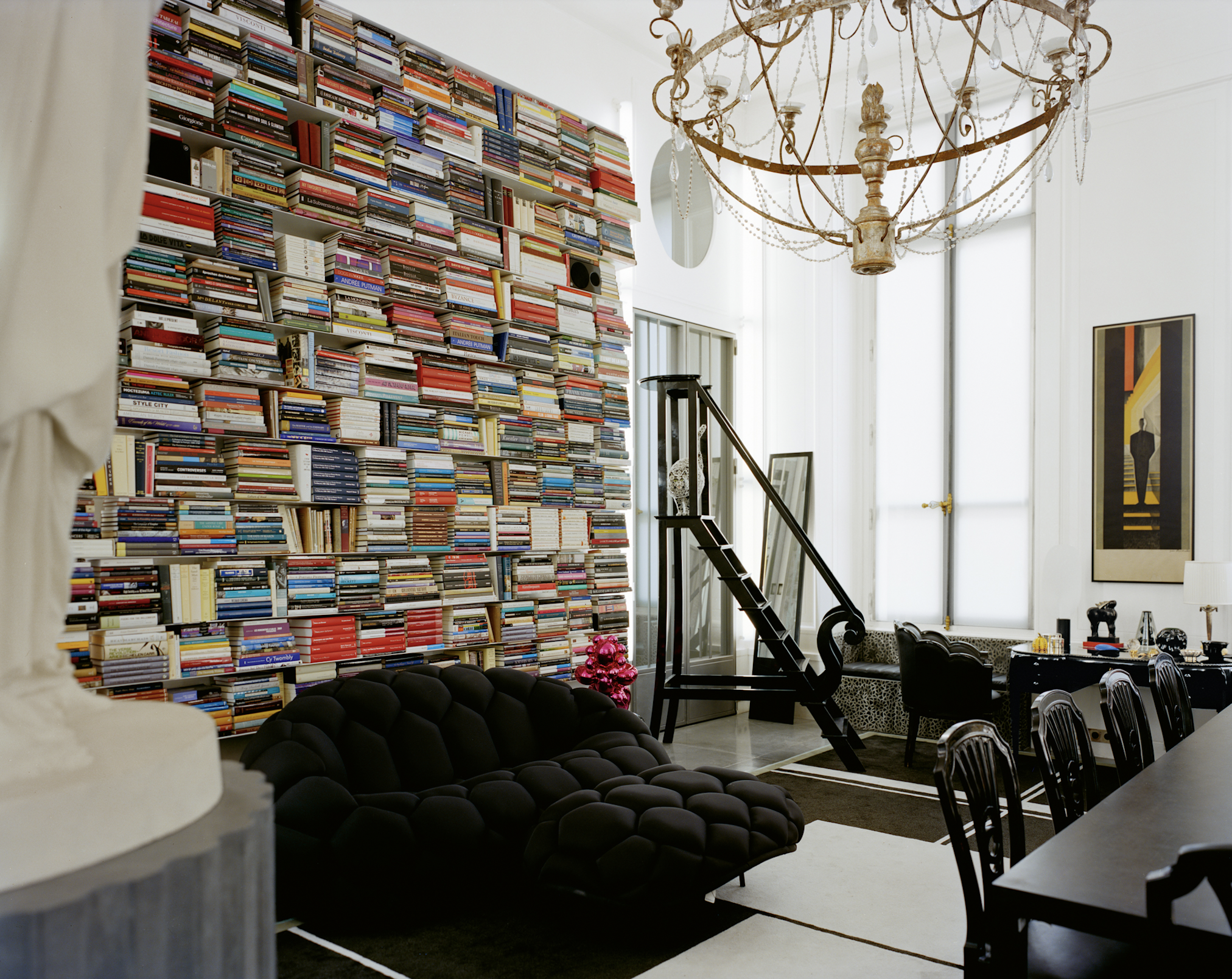
In fact, when the first Lagerfeld interior was featured in a 1968 spread for L’OEil magazine, the editorial describes him merely as a “stylist”. The photographs of the apartment in an 18th-century mansion on rue de Université, show walls lined with plum-coloured rice paper, or lacquered deepest chocolate brown in sharp contrast to crisp, white low ceilings that accentuated the horizontality that was fashionable among the extremely fashionable at the time. Yet amid this setting of aggressively au courant modernism, the anachronistic pops of Art Nouveau and Art Deco objects foreshadow the young Karl’s innate gift for creating strikingly original environments whose harmony is achieved through the deft interplay of contrasting styles and contexts.
Lagerfeld learned early on that presenting himself in a succession of gem-like domestic settings was good for crafting his image. But Lagerfeld’s houses not only provided him with publicity, they also gave him an excuse to indulge in his greatest passion. Shopping!
By 1973, Lagerfeld was living in a new apartment at Place Saint–Sulpice where his acquisition of important Art Deco treasures continued unabated. Now a bearded and muscular disco dandy, he could most often be found in the louche company of the models, starlets and assorted hedonistic beauties that gathered around the flamboyant fashion illustrator Antonio Lopez. Lagerfeld was also in the throes of a hopeless love affair with Jacques de Bascher whose favours he reluctantly shared with his nemesis Yves Saint Laurent.
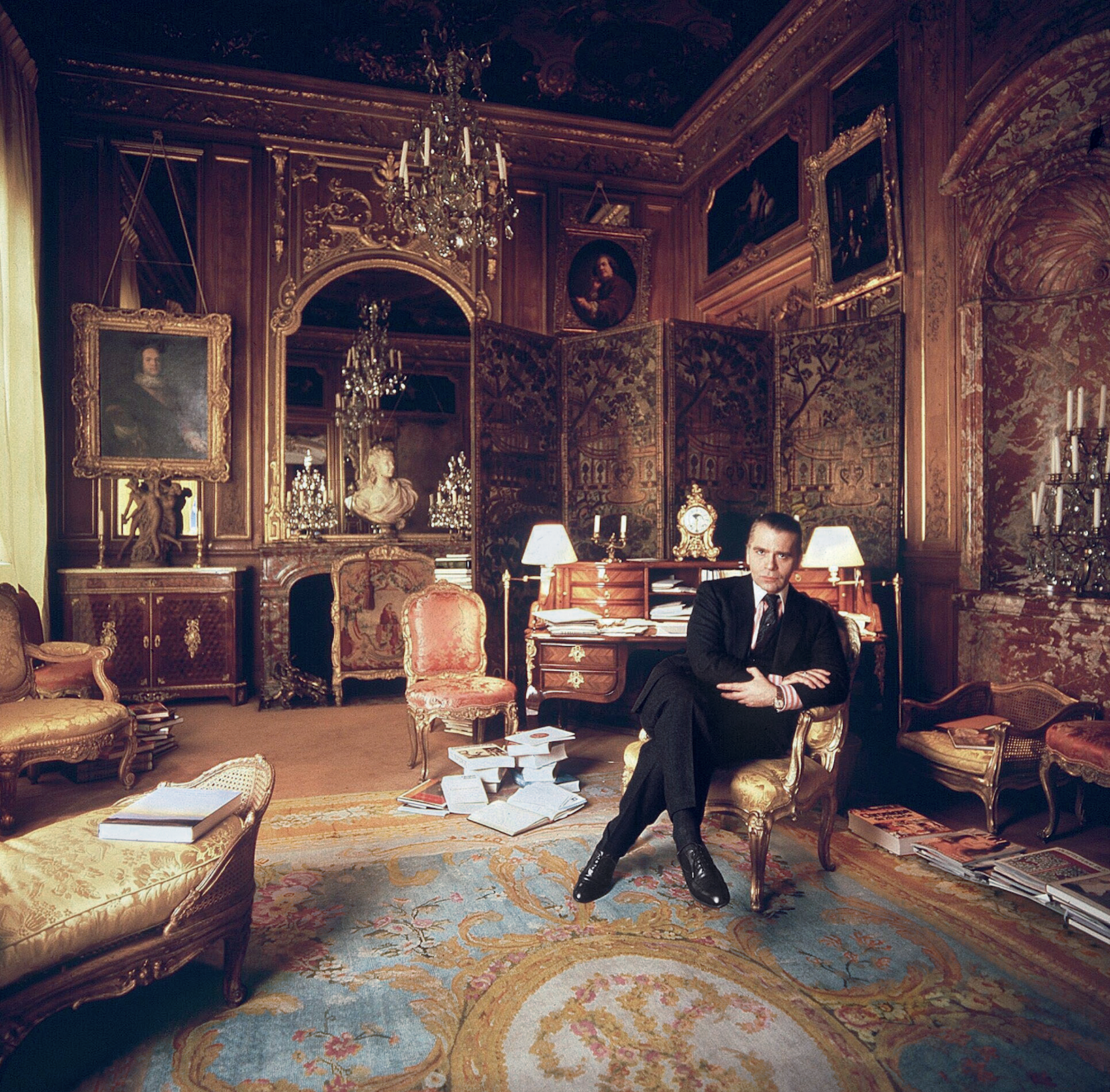
He painted the rooms milky white and lined them with specially commissioned carpets—the tawny patterned striations of which invoked musky wild animal pelts. These lent a stark relief to the sleek, machine-age chrome lines of his Deco furnishings. To contemporary eyes it remains a strikingly original arrangement that subtly conveys the tensions at play in Lagerfeld’s own life: the cocaine fuelled orgies of his lover and friends, hosted in the pristine home of a man who claimed that “a bed is for one person”.
In 1975, a painful falling out with his beloved Jacques, who was descending into the abyss of addiction, saw almost his entire collection of peerless Art Deco furniture, paintings and objects put under the auctioneer’s hammer. This was the first of many auction sales, as he habitually shed the contents of his houses along with whatever incarnation of himself had lived there. Lagerfeld was dispassionate about parting with these precious goods. “It’s collecting that’s fun, not owning,” he said. And the reality for a collector on such a Renaissance scale, is that to continue buying, Lagerfeld had to sell.
Of all his residences, it was the 1977 purchase of Hôtel Pozzo di Borgo, a grand and beautifully preserved 18th-century house, that would finally allow him to fulfill his childhood fantasies of life in the court of Madame de Pompadour. And it was in this aura of Rococó splendour that the fashion designer began to affect, along with his tailored three-piece suits, a courtier’s ponytailed and powdered coif and a coquettish antique fan: marking the beginning of his transformation into a living, breathing global brand that even those with little interest in fashion would immediately recognise.
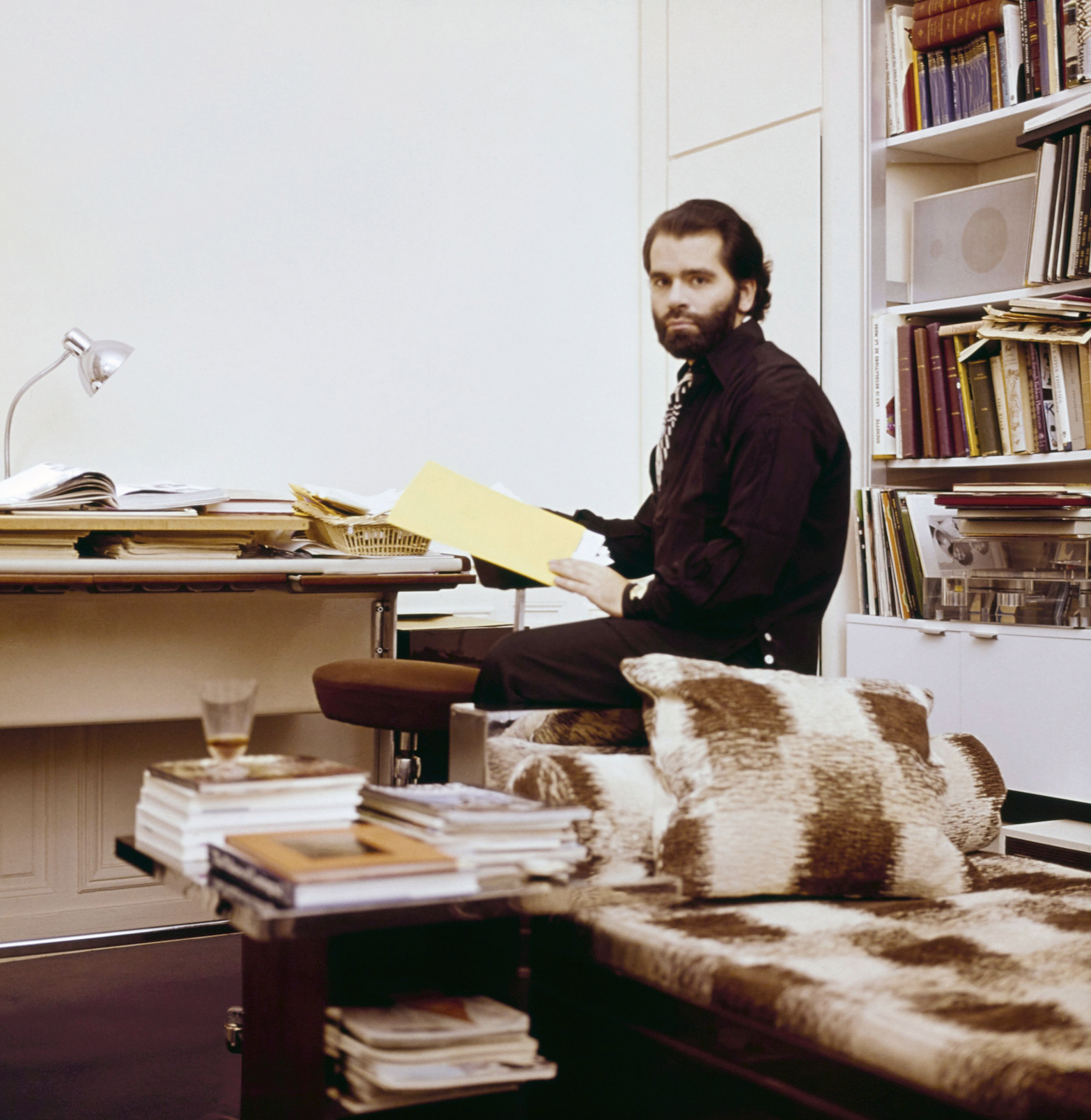
Lagerfeld’s increasing fame and financial success allowed him to indulge in an unprecedented spending frenzy, competing with deep-pocketed institutions like the Louvre to acquire the finest, most pedigreed pearls of the era—voluptuously carved and gilded bergères; ormolu chests; and fleshy, pastel-tinged Fragonard idylls—to adorn his urban palace. His one-time friend André Leon Talley described him in a contemporary article as suffering from “Versailles complex”.
However, in mid-1981, and in response to the election of left-wing president, François Mitterrand, Lagerfeld, with the assistance of his close friend Princess Caroline, became a resident of the tax haven of Monaco. He purchased two apartments on the 21st floor of Le Roccabella, a luxury residential block designed by Gio Ponti. One, in which he kept Jacques de Bascher, with whom he was now reconciled, was decorated in the strict, monochromatic Viennese Secessionist style that had long underpinned his aesthetic vocabulary; the other space, though, was something else entirely, cementing his notoriety as an iconoclastic tastemaker.
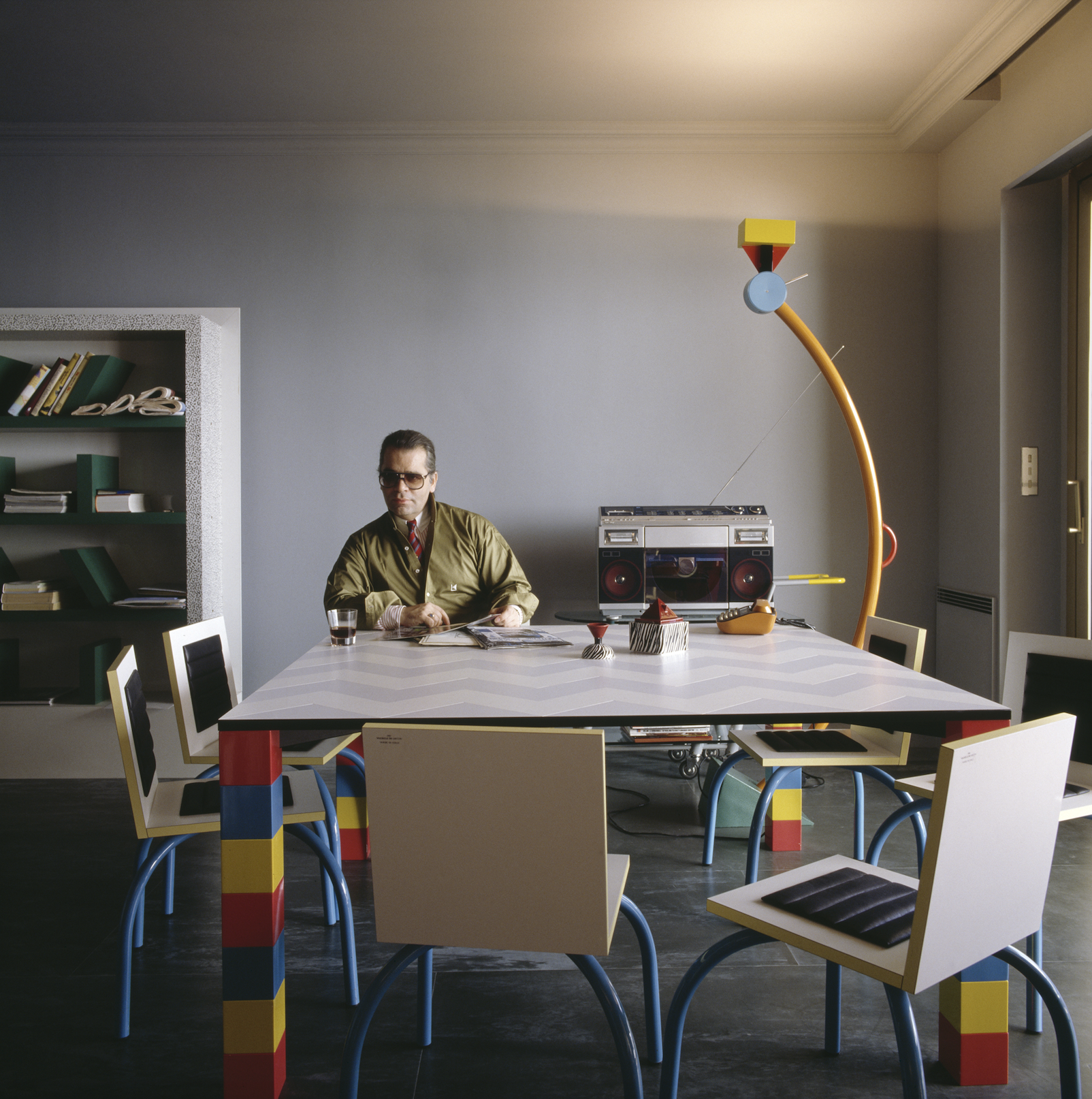
Lagerfeld had recently discovered the radically quirky designs of the Memphis Group led by Ettore Sottsass, and bought the collective’s entire first collection and had it shipped to Monaco. In a space with no right angles, these chaotically colourful, geometrically askew pieces—centred on Masanori Umeda’s famous boxing ring—gave visitors the disorientating sensation of having entered a corporeal comic strip. By 1991, the novelty of this jarring postmodern playhouse had inevitably worn thin and once again he sent it all to auction, later telling a journalist that “after a few years it was like living in an old Courrèges. Ha!”
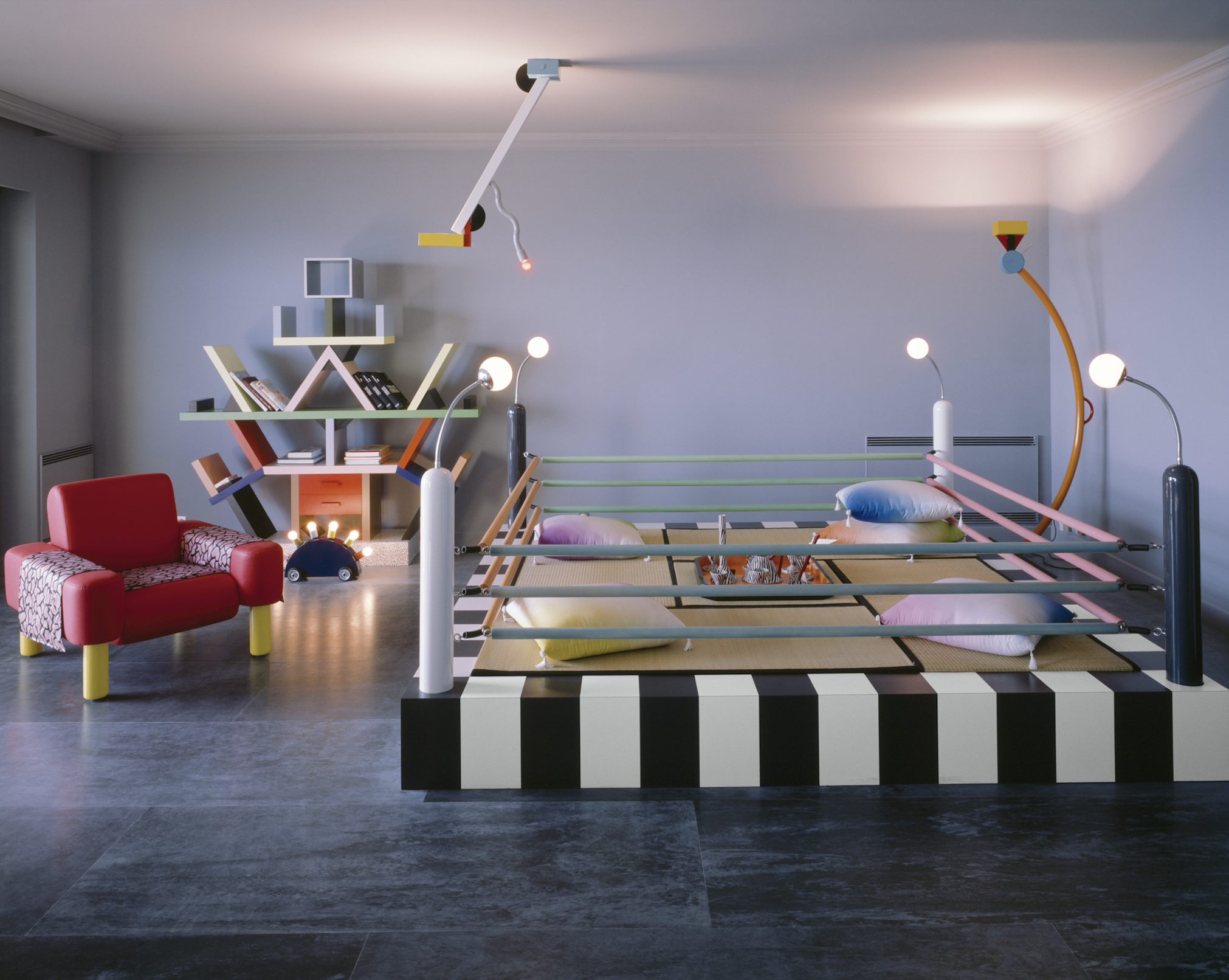
In 1989, de Bascher died of an AIDS-related illness, and while Lagerfeld’s career continued to flourish, emotionally the famously stoic designer was struggling. In 2000, a somewhat corpulent Lagerfeld officially ended his “let them eat cake” years at the Hôtel Pozzo di Borgo, selling its sumptuous antique fittings in a massive headline auction that stretched over three days. As always there were other houses, but now with his longtime companion dead, and his celebrity metastasising making him a target for the paparazzi, he began to look less for exhibition spaces and more for private sanctuaries where he could pursue his endless, often lonely, work.
His next significant house was Villa Jako, named for his lost companion and built in the 1920s in a nouveau riche area of Hamburg close to where he grew up. Lagerfeld shot the advertising campaign for Lagerfeld Jako there—a fragrance created in memorial to de Bascher. The house featured a collection of mainly Scandinavian antiques, marking the aesthetic cusp between Art Nouveau and Art Deco. One of its rooms Lagerfeld decorated based on his remembrances of his childhood nursery. Here, he locked himself away to work—tellingly—on a series of illustrations for the fairy tale, The Emperor’s New Clothes. Villa Jako was a house of deep nostalgia and mourning.
But there were more acts—and more houses—to come in Lagerfeld’s life yet. In November 2000, upon seeing the attenuated tailoring of Hedi Slimane, then head of menswear at Christian Dior, the 135 kg Lagerfeld embarked on a strict dietary regime. Over the next 13 months, he melted into a shadow of his former self. It is this incarnation of Lagerfeld—high white starched collars; Slimane’s skintight suits, and fingerless leather gloves revealing hands bedecked with heavy silver rings—that is immediately recognisable some five years after his death.
The 200-year-old apartment in Quái Voltaire, Paris, was purchased in 2006, and after years of slumber Lagerfeld—a newly awakened Hip Van Winkle—was ready to remake it into his last modernist masterpiece. He designed a unique daylight simulation system that meant the monochromatic space was completely without shadows—and without memory. The walls were frosted and smoked glass, the floors concrete and silicone; and any hint of texture was banned with only shiny, sleek pieces by Marc Newson, Martin Szekely and the Bouroullec Brothers permitted. Few guests were allowed into this monastic environment where Lagerfeld worked, drank endless cans of Diet Coke and communed with Choupette, his beloved Birman cat, and parts of his collection of 300,000 books—one of the largest private collections in the world.
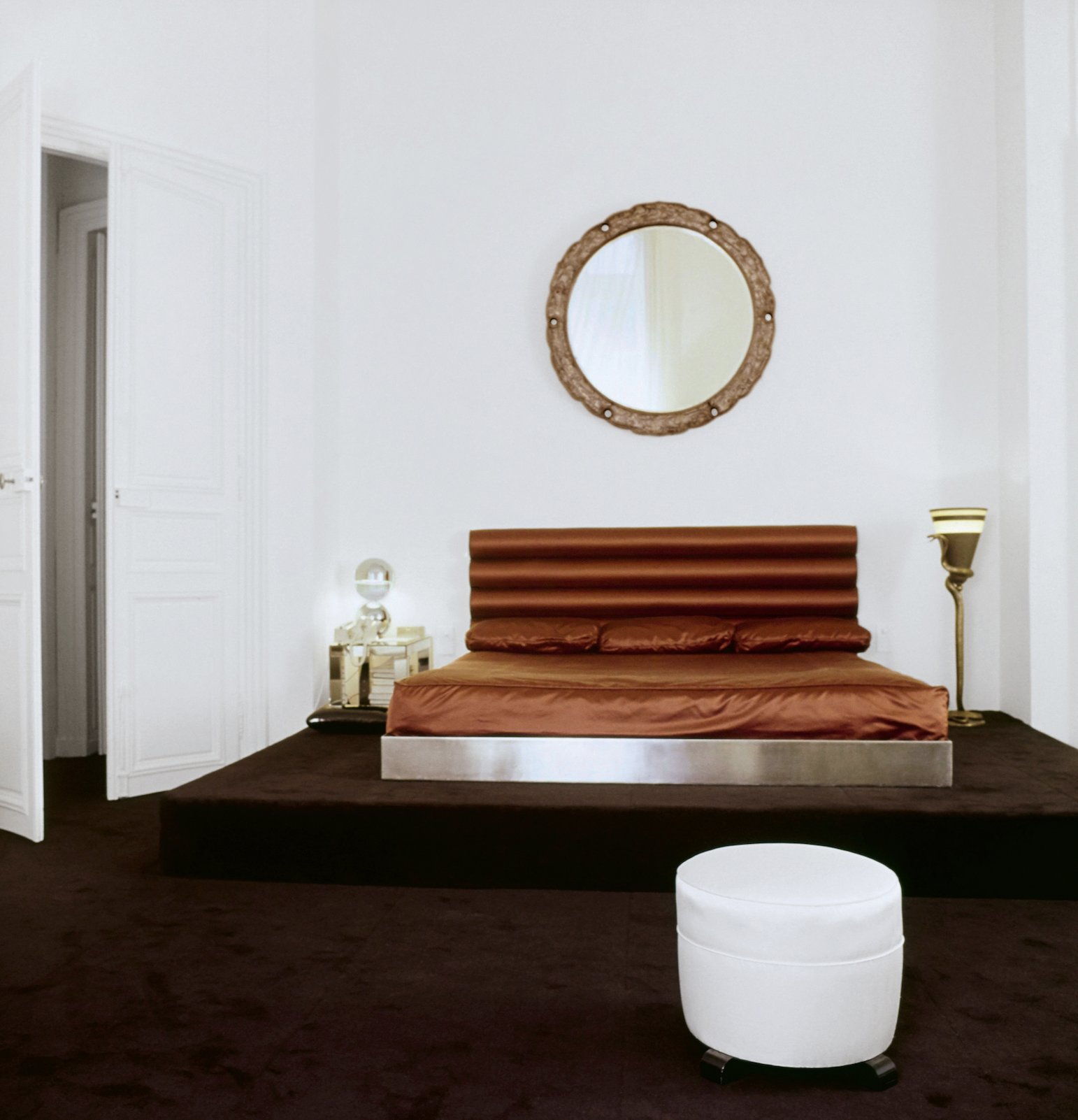
Lagerfeld died in 2019, and the process of dispersing his worldly goods is still ongoing. The Quái Voltaire apartment was sold this year for US$10.8 million (around $16.3 million). Now only the rue de Saint-Peres property remains within the Lagerfeld trust. Purchased after Quái Voltaire to further accommodate more of his books—35,000 were displayed in his studio alone, always stacked horizontally so he could read the titles without straining his neck—and as a place for food preparation as he loathed his primary living space having any trace of cooking smells. Today, the rue de Saint-Peres residence is open to the public as an arts performance space and most fittingly, a library.
You may also like.
By Josh Bozin
24/07/2024
Watch This Space: Mike Nouveau
Meet the game-changing horological influencers blazing a trail across social media—and doing things their own way.
In the thriving world of luxury watches, few people own a space that offers unfiltered digital amplification. And that’s precisely what makes the likes of Brynn Wallner, Teddy Baldassarre, Mike Nouveau and Justin Hast so compelling.
These thought-provoking digital crusaders are now paving the way for the story of watches to be told, and shown, in a new light. Speaking to thousands of followers on the daily—mainly via TikTok, Instagram and YouTube—these progressive commentators represent the new guard of watch pundits. And they’re swaying the opinions, and dollars, of the up-and-coming generations who now represent the target consumer of this booming sector.
—
MIKE NOUVEAU

Can we please see what’s on the wrist? That’s the question that catapulted Mike Nouveau into watch stardom, thanks to his penchant for highlighting incredibly rare timepieces across his TikTok account of more than 400,000 followers. When viewing Nouveau’s attention-grabbing video clips—usually shot in a New York City neighbourhood—it’s not uncommon to find him wrist-rolling some of the world’s rarest timepieces, like the million-dollar Cartier Cheich (a clip he posted in May).
But how did someone without any previous watch experience come to amass such a cult following, and in the process gain access to some of the world’s most coveted timepieces? Nouveau admits had been a collector for many years, but moved didn’t move into horology full-time until 2020, when he swapped his DJing career for one as a vintage watch specialist.
“I probably researched for a year before I even bought my first watch,” says Nouveau, alluding to his Rolex GMT Master “Pepsi” ref. 1675 from 1967, a lionised timepiece in the vintage cosmos. “I would see deals arise that I knew were very good, but they weren’t necessarily watches that I wanted to buy myself. I eventually started buying and selling, flipping just for fun because I knew how to spot a good deal.”
Nouveau claims that before launching his TikTok account in the wake of Covid-19, no one in the watch community knew he existed. “There really wasn’t much watch content, if any, on TikTok before I started posting, especially talking about vintage watches. There’s still not that many voices for vintage watches, period,” says Nouveau. “It just so happens that my audience probably skews younger, and I’d say there are just as many young people interested in vintage watches as there are in modern watches.”
View this post on Instagram
Nouveau recently posted a video to his TikTok account revealing that the average price of a watch purchased by Gen Z is now almost US$11,000 (around $16,500), with 41 percent of them coming into possession of a luxury watch in the past 12 months.
“Do as much independent research as you can [when buying],” he advises. “The more you do, the more informed you are and the less likely you are to make a mistake. And don’t bring modern watch expectations to the vintage world because it’s very different. People say, ‘buy the dealer’, but I don’t do that. I trust myself and myself only.”
—
Read more about the influencers shaking up horology here with Justin Hast, Brynn Wallner and Teddy Baldassare.
You may also like.
By Josh Bozin
24/07/2024
This Pristine 1960 Ferrari 250 Spider Could Fetch $24 Million at Auction
The car wears the same colours and has the same engine it left the factory with.
Some Ferraris are just a little bit more important than others.
Take, for example, the 1960 250 GT SWB California that RM Sotheby’s is auctioning off during this year’s Monterey Car Week. Any example of the open-top beauty would attract interest, but this one just so happens to be the first one that was built.
The 250 is one of the most legendary series of cars in Ferrari history. Between 1952 and 1964, the company released 21 different 250 models—seven for racetracks, 14 for public roads—of which the “Cali Spider” might be the most well regarded, thanks to its potent V-12 and a Pininfarina-penned design that is one of the most beautiful bodies to grace an automobile. The roadster, which was specifically built for the U.S., made its debut in 1957 as a long-wheel-base model (LWB), but it wasn’t until the SWB model debut in 1960 that it became clear how special it was. This example isn’t just the first to roll off the line. It’s the actual car that was used to introduce the world to the model at the 1960 Geneva Motor Show.
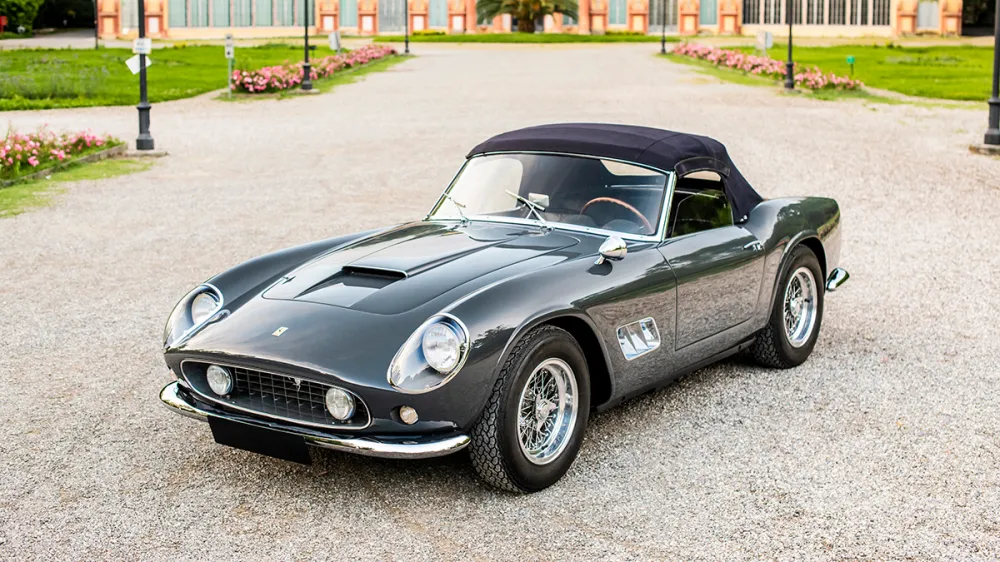
Just 56 examples of the 250 GT SWB California Spider would be built by Scaglietti during the three years it was in production. The first of those, chassis 1795 GT, is finished in a glossy coat of Grigio. The two-door had a red leather interior at Geneva but was returned to the factory and re-outfitted with black leather upholstery before being delivered to its original owner, British race car driver John Gordon Bennet. Six-and-a-half decades later the car looks identical to how it did when it left the factory the second time.
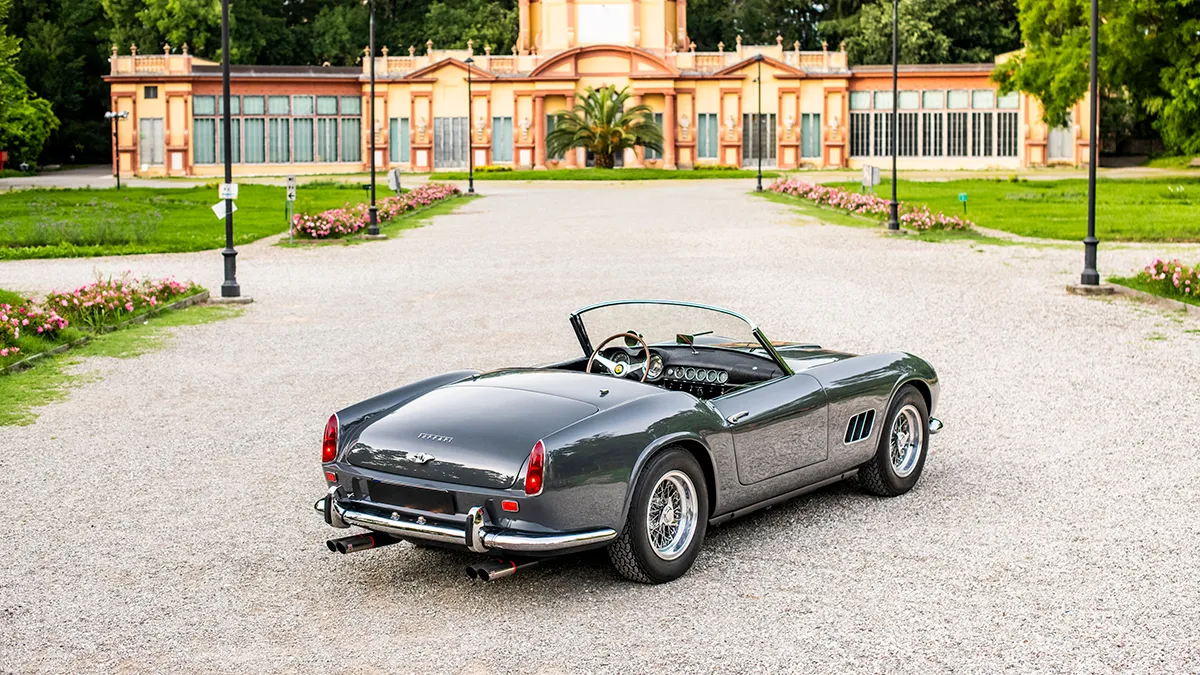
In addition to its original bodywork, the chassis 1795 GT features its original engine, gearbox, and rear axle. That mill is the competition-spec Tipo 168, a 3.0-litre V-12 that makes 196.1 kW. That may not sound like much by today’s standards, but, when you consider that the 250 GT SWB California Spider tips the scales around 952 kilograms, it’s more than enough.
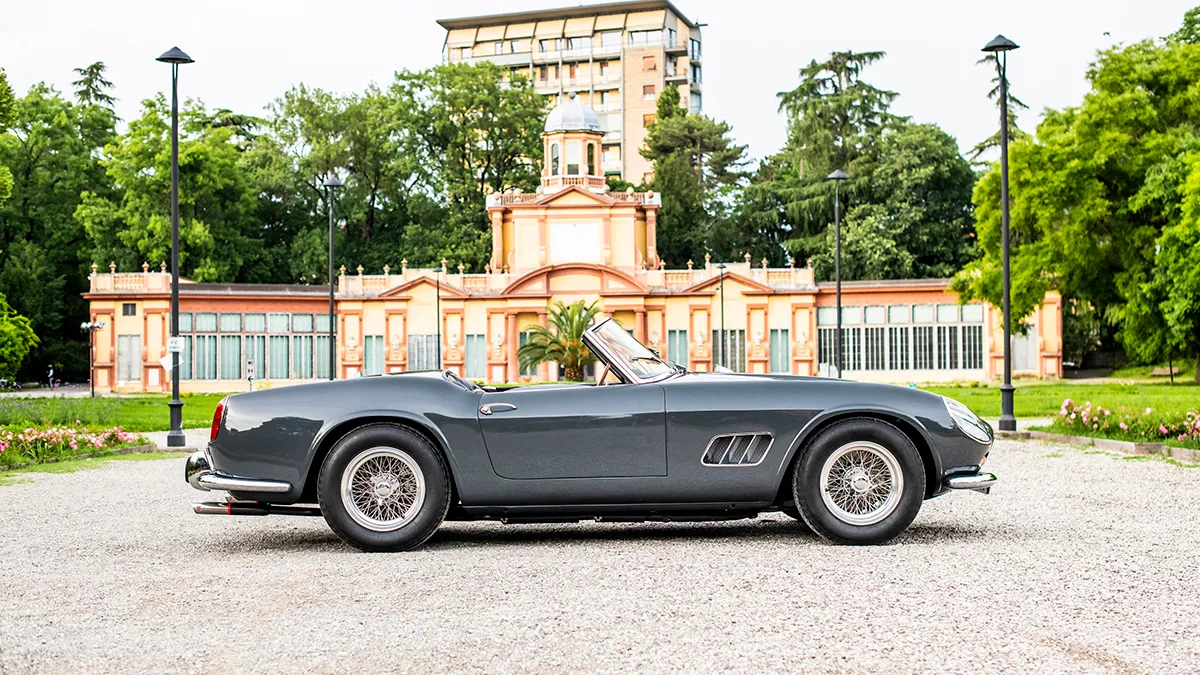
The first 250 GT SWB California Spider is scheduled to go up for bid during RM Sotheby’s annual Monterey Car Week auction, which runs from Thursday, August 15, to Saturday, August 17. Unsurprisingly, the house has quite high hopes for the car. The car carries an estimate of between $24 million and $26 million, which could make it one of the most expensive cars ever sold at auction.
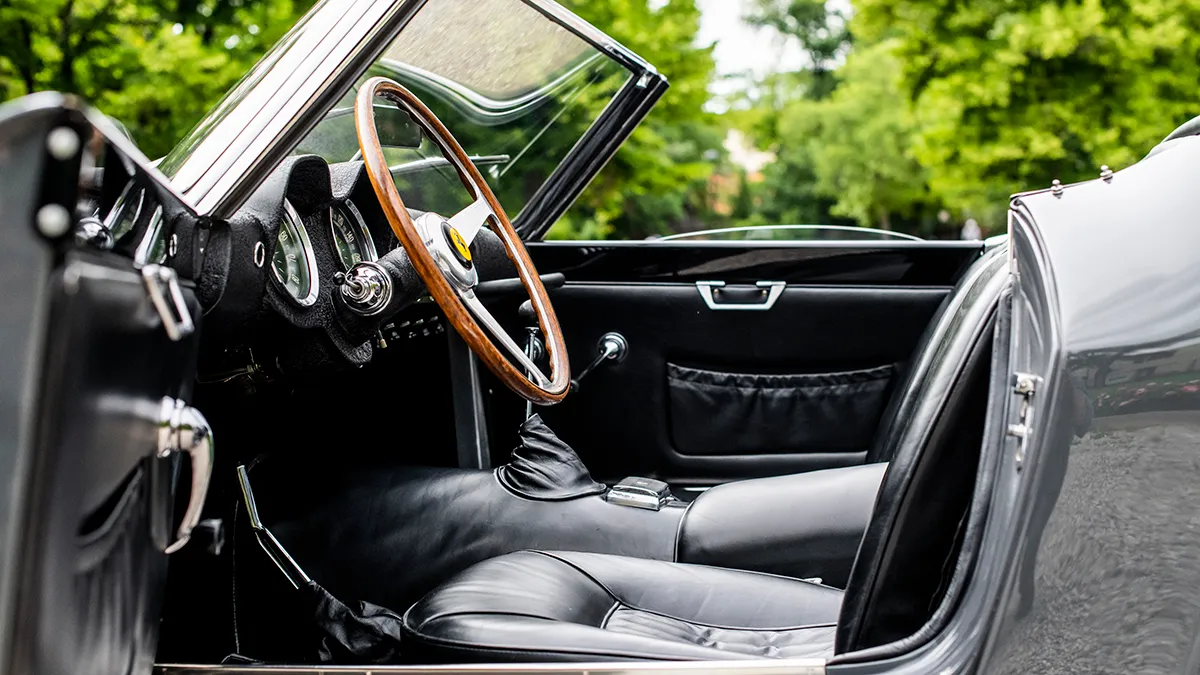
You may also like.
By Josh Bozin
24/07/2024







